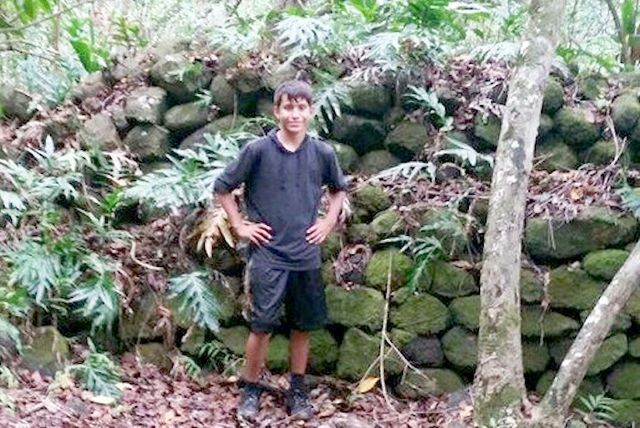Recently, I invited my teenaged grandson, Bradshaw Soboleski, to hike with me to Kihe Heiau, tucked away within the shaded solitude of little Kihe Valley in the Moloaa Forest Reserve of Kauai. I’d come across this heiau while hiking alone
Recently, I invited my teenaged grandson, Bradshaw Soboleski, to hike with me to Kihe Heiau, tucked away within the shaded solitude of little Kihe Valley in the Moloaa Forest Reserve of Kauai.
I’d come across this heiau while hiking alone awhile back, but Bradshaw had never been there, and I was pleased to learn that he was curious to see it with me.
Both of us understood beforehand that Kihe Heiau was a sacred religious site to be treated with respect and to be left undisturbed.
Built sometime before Captain Cook’s discovery in 1778, Kihe Heiau is described in Wendell Clark Bennett’s authoritative “Archaeology Of Kauai,” and is listed on the Hawaii State Register of Historic Places, but it is nowadays otherwise practically unknown and seldom visited.
But, long ago, countless offerings to Hawaiian gods over a great many years were made there by alii and priests of the old Hawaiian religion, and innumerable people must have set foot upon its hallowed grounds.
While we carefully explored the heiau’s remarkably well-preserved stonework occupying a roughly 80-foot by 120-foot area, I suggested to Bradshaw that his own Native Hawaiian forebears may have spent time there in the distant past.
He smiled but said nothing, and I like to imagine that he was perhaps happy to sense a bond between himself and Kihe Heiau extending far back in time to Hawaiian antiquity.
According to Bennett, Kihe Heiau is comprised of a paved platform 8 by 10 feet; a house site 8 by 15 feet outlined by a line of stones; an oven; a dirt-paved division 60 by 68 feet inside; three rooms 14 feet wide and 9 to 28 feet long; a wall 3 feet high and 5 feet wide; a step 2 feet high, 5 feet wide; another step 1 foot high, 5 feet wide and a second dirt-paved division 46 by 46 feet.
Later, as Bradshaw and I were leaving, we thanked whatever spirits that may have been present with us among the heiau’s ancient stones.



